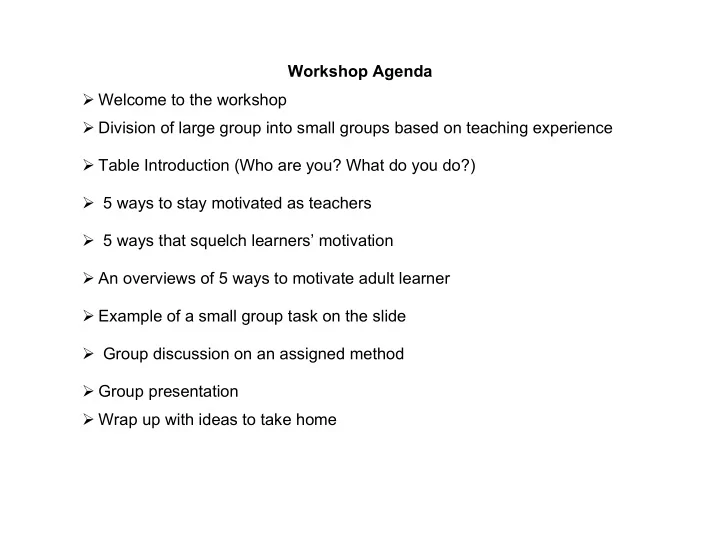

Workshop Agenda Welcome to the workshop Division of large group into small groups based on teaching experience Table Introduction (Who are you? What do you do?) 5 ways to stay motivated as teachers 5 ways that squelch learners’ motivation An overviews of 5 ways to motivate adult learner Example of a small group task on the slide Group discussion on an assigned method Group presentation Wrap up with ideas to take home
5 Ways to Motivate Adult Learners 1. Create a Need 2. Create and Maintain Interest (Rule:90/20/8) 3. Incorporate Instructional Behaviours 4. 4. Structure the Course 5. Respond to Learners’ Work
5 WAYS TO SQUELCH MOTIVATION Instructions: At your table please complete the following phrases with appropriate word/words and add 2 more complete phrases to the list. 1) Have little _________________________________________________. 2) Get participants in a ______________________ and keep them there. 3) ____________________ the class will apply what is taught-don’t bother with examples. 4) Be quick to _______________________________________. 5) Make learners __________________________ for asking questions in class. 6) 7)
BLOOM’S TAXONOMY 6 LEVELS OF TAXONOMY 1. KNOWLEDGE 2. COMPREHENSION 3. APPLICATION 4. ANYLYSIS 5. SYNTHESIS 6. EVALUATION
1. CREATE A NEED 1. Key needs assessment questions from a teacher’s 2. Discuss the questions on the left in a small group perspective: and answer each one of them in the reflection of your work contexts. 1. WII-FM (What is in it for my learners?) 2. Make me impressed about myself MMI-AM (How can I make learners impressed about them?) 3. Why do I need to bring learners’ real life in the class? 4. How can they make use of it in a practical way, real way? Add 2 more questions to the list:
2. CREATE and MAINTAIN INTEREST (Rule: 90/20/8) 1. Key features of creating and maintaining interest: 2. Discuss the features on the left in a small group and give examples for each in the reflection of your work contexts. 1. Basic principle of motivation: You cannot motivate other people; you can only create a climate or an environment in which they can motivate themselves. 2. Use discussions, lectures, films, overhead transparencies, projects and case studies as opposed to relying exclusively upon games and role plays. 3. In a- 90 minute class, pace is changed every 20 minutes, and participants get involved every 8 minutes. Add 2 more features to the list:
3. INCORPORATE INSTRUCTIONAL BEHAVIOURS THAT MOTIVATE STUDENTS 1. Key features of Incorporating Instructional Behaviours 2. Discuss the features on the left in a small group and give examples for each in the reflection of your work contexts. That Motivate Students: 1. Hold high but realistic expectations for your students 2. Help learners set achievable goals for themselves 3. Tell learners what they need to do to succeed in your course 4. Strengthen learners' self-motivation 5. Avoid creating intense competition among learners 6. Be enthusiastic about your teaching Add 2 more features to the list:
4. STRUCTURE THE COURSE 1. Key features of structuring the course: 2. Discuss the features on the left in a small group and give examples for each in the reflection of your work contexts. 1. Work from students' strengths and interests 2. When possible, let students have some say in choosing what will be studied 3. Vary your teaching methods 4. Emphasize mastery and learning rather than grades 5. Design tests that encourage the kind of learning you want students to achieve 6. Avoid using grades as threats Add 2 more features to the list:
5. RESPOND TO LEARNERNS’ WORK 1. Key features of responding to learners’ work: 2. Discuss the features on the left in a small group and give examples for each in the reflection of your work contexts. 1. Give learners feedback as quickly as possible 2. Reward success in many ways 3. Introduce learners to the good work done by their peers 4. Avoid demeaning comments Add 2 more features to the list:
Recommend
More recommend